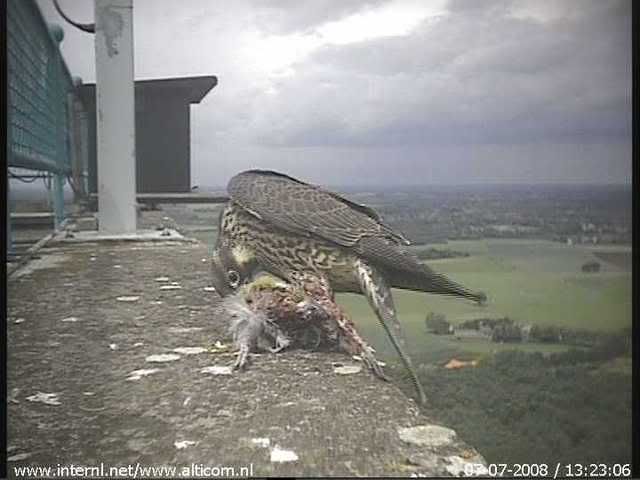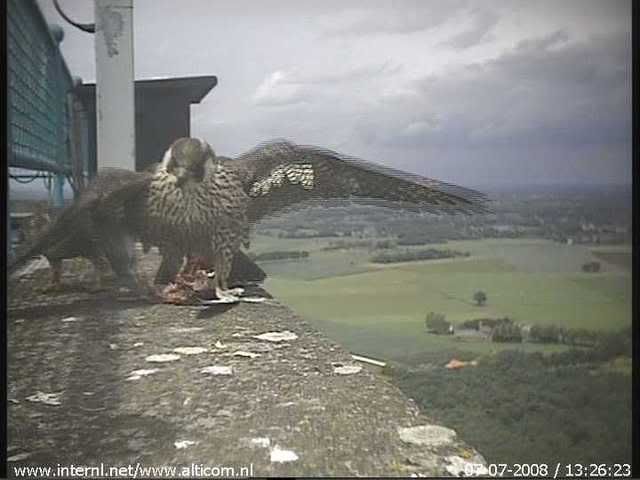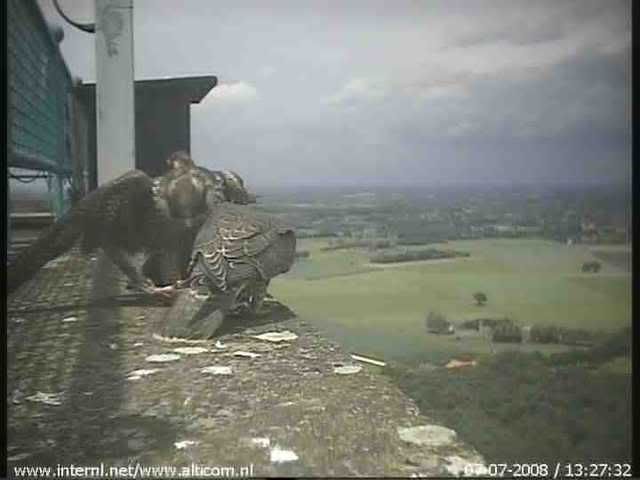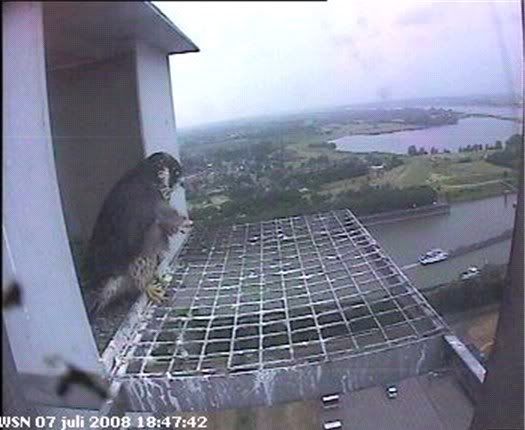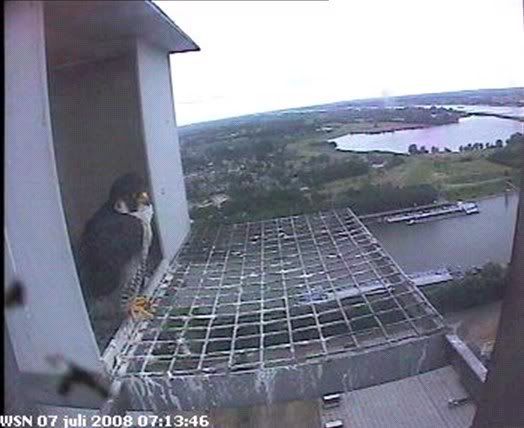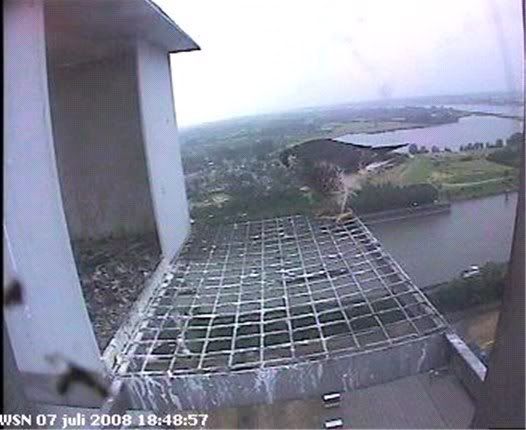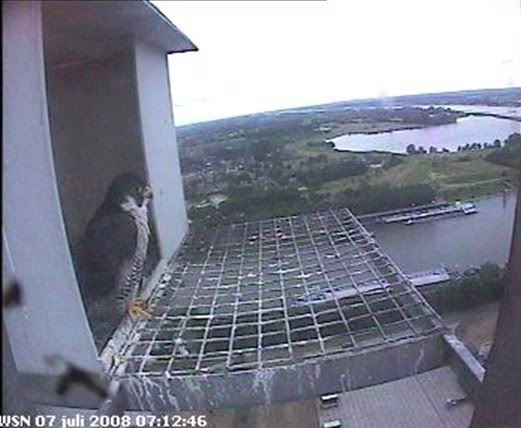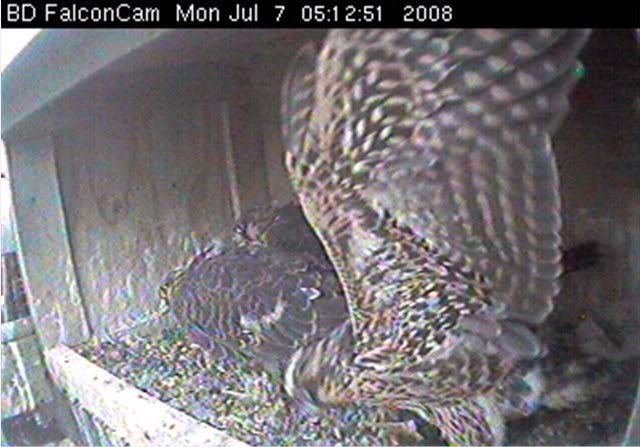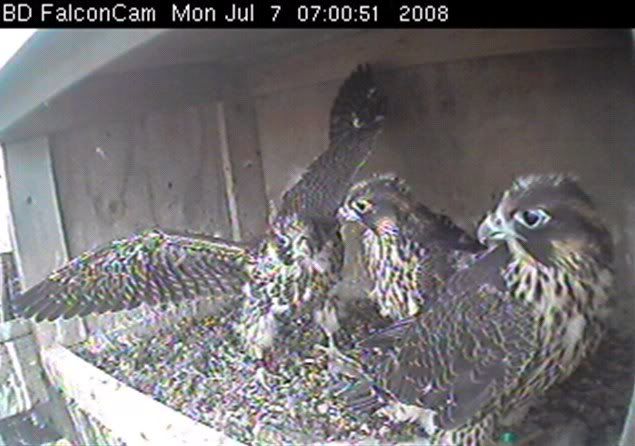
Mariah and Kaver of Rochester. They are special. For many years now the beautiful Mariah is the resident falcon of the Rochester Kodak nestsite. After Sirocco did not come back from migration Kaver has taken his place. They are together now for 7 years. Mariah has fledged 43 juvies. After the season is over and the juvies have left the Gorge on their way to destiny, Kaver says goodbye as well. He leaves on migration as soon as the first leaves start to fall. Leaving his Mariah in Rochester.
And although they are renewing their vows at the moment with bonding rituals in the nestbox, Mariah has to spent the winter alone. She chooses to!
Why? I received some questions about migration. Why do some peregrines leave on migration and why do others stay?
About migrationThe peregrine falcon always has been a wanderer. It's very name "peregrine" means wandering. The German name of the peregrine falcon is Wanderfalke. So for as long as we can remember this amazing raptor is one who wanders the earth. But why?
All habits of animals have everything to do with food. They need to eat. So they nest and live there where there is enough food. For the peregrine falcon that means that they go where there are enough preybirds in the area.
From long before we know there is this spectacular birdmigration in the autumn when all leave for the warm south. In Northern Europe birds leave for Africa. In the America's they go to South America.

The prey birds that peregrines eat migrate south, so peregrines have to migrate south as well. In general, peregrines and all other birds migrate south to warmer weather for the winter. However, during the migration, weather patterns, storms, winds and other factors influence the direction or route they take. But generally they still end up in the same wintering locations. Each peregrine has a place to where he returns in the winter. The whole peregrine family used to go on migration, with the juveniles! They would spent their first winter on migrationgrounds, being tolerated by the adults.
DDTThe DDT crisis however changed everything. It caused a major shift in the peregrine population all over the world. Many well populated areas where completely whiped out. In the US as well as in Northern and Eastern Europe and North Africa. Only Australia was not affected by the DDT.
The reintroduction programs introduced the peregrine falcon not only in the country and mountainareas but in to the big cities as well. Especially in the US and Canada. And the peregrine falcon adapted wonderfully! In Europe there have been some hackingprograms as well, but the peregrines have have been introduced mainly in wildlife parks, not in the cities.
For the peregrine falcon the big city is some kind of ideal Rocky Mountain area. With high cliffs, ridges, trees, wonderful up- and downdrafts, thermals, water and lots and lots of prey: city pigeons (or high cholesterol macdonald pigeons ;)), and all kind of other small birds. And these preybirds do not migrate. Because why would they in the first place? There is enough food for them in the city, even in the winter. It's warm, there is shelter enough and lots of restaurants with plenty of leftover food etc.
So there is no need for the city peregrine falcon to migrate anymore. Their prey stays so they do as well. Easy as that it is. They can very well survive in the northern parts of the country in the winter. And so the peregrine falcon can decide for himself to leave or not to leave. Kaver of Rochester follows his instinct and leaves. But Mariah makes her choice and stays in Rochester, where there are lots of pigeons etc. Her bond with the nestbox is so strong that she'd rather stay home.

click on the image to enlarge
This change in migration behaviour does cause problems however. When one of the partners migrates and the other does not, it can happen that there is courtship going on with a third intruding peregrine when the migrating partner returns in spring. Which happened in Cleveland for instance in 2001. Young, powerfull and healthy SW presented herself to Buckeye and had already laid 4 eggs when Buckeye's partner Zenith returned. The tired and exhausted Zenith lost her battle with SW within 30 minutes and she died on a ledge of the Terninal Tower. SW and Buckeye both stay during the winter at their nestsite on terminal Tower. Neither migrates.
In our country, the Netherlands, half of our peregrine population are migrating from Scandinavia. THose peregrine falcons fly back to their nesting cliff in the spring. They return in the fall to spent the winter again in our country. So we are very happy with some resident pairs, like S2 and Pa in De Mortel who stay on the Tower even during the winter.
Making milesOf course there are many migration projects, with remarkable results.
Like this on:
61 Peregrine Falcons captured at nest sites across the North American boreal forest and low Arctic or on the migration routes along the mid-Atlantic and Gulf of Mexico coasts where provided with a tracking device.
The average distance of migration for Peregrines was 8,624 km southward, and 8,247 km northward. Peregrines travelled at an average rate of 172 km/d southward and 198 km/d going north. Peregrine Falcons used at least three broad, general routes south from the breeding areas, and individuals stopped migrating as far north as the U.S.A. mid-Atlantic coast and as far south as central Argentina. The radiomarked Peregrine Falcons used coastal routes, mid-continental routes, and water-crossing routes: the Davis Strait and Caribbean Sea. During northward migration, Peregrines migrating through at Padre Island, Texas diverged for destinations from central Alaska across the continent to central West Greenland.

This year one of the Rochester juvies, young falcon Quest, received a transmitter, so we can watch where her travels go to, and where she possibly migrates to.
Her father Kaver, he will probably leave for his hacienda in Argentina to spent a warm and comfortable winter in the tropical sun enjoying tasty pigeon cuisine abroad.

















